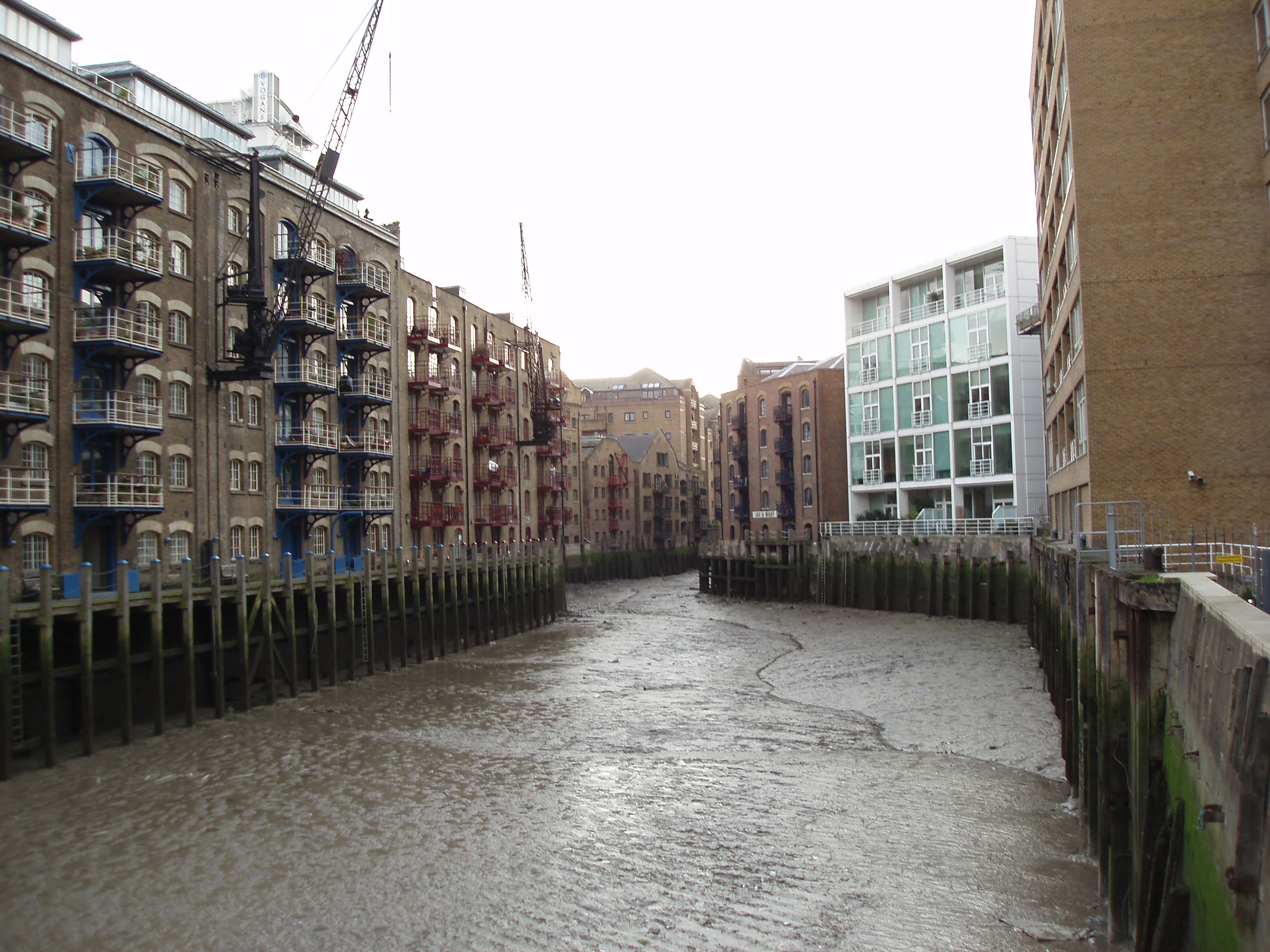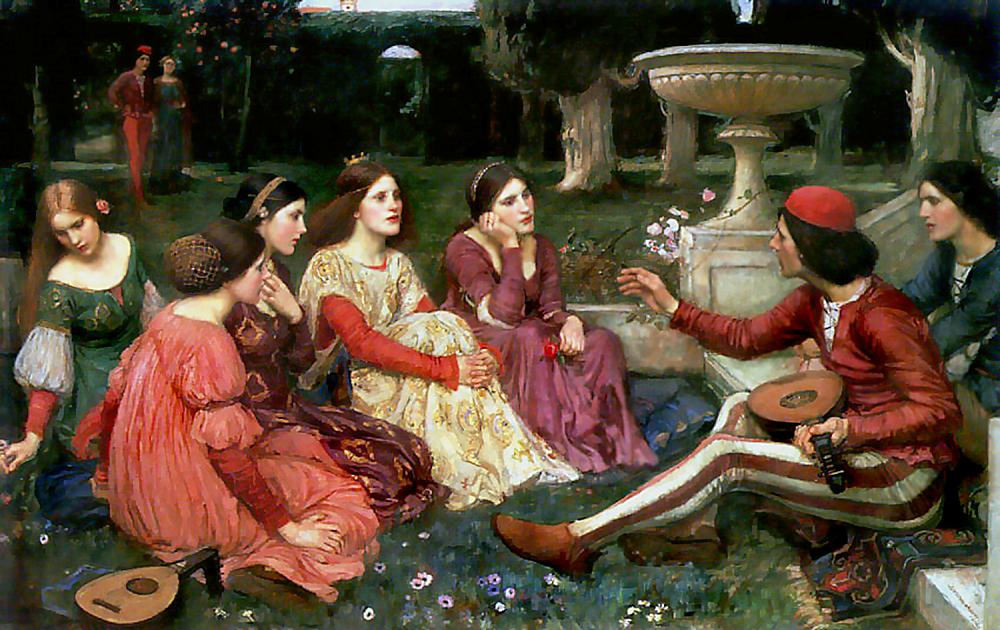|
River Neckinger
The River Neckinger is a reduced subterranean river that rises in Southwark and flows approximately through that part of London to St Saviour's Dock where it enters the Thames. What remains of the river is enclosed and runs underground and most of its narrow catchment has been diverted into other combined and surface water sewers, flowing into the Southern Outfall Sewer and the Thames respectively. Course The watercourse drained first the seasonally wet (and occasionally flooded) ground at St George's Fields, now Geraldine Mary Harmsworth Park, in western Southwark. Its course was east as follows: it took the line of Brook Drive then passed by the Elephant and Castle, then passed the site of Lock Hospital, Kent Street. This upper section was also known before that hospital's closure in the early 19th century as the Lock Stream. It then passed the grounds of (since demolished) Bermondsey Abbey to the south, forming the channel north of what was the large Thames island of Bermo ... [...More Info...] [...Related Items...] OR: [Wikipedia] [Google] [Baidu] |
Tide Mill
A tide mill is a water mill driven by tidal rise and fall. A dam with a sluice is created across a suitable tidal inlet, or a section of river estuary is made into a reservoir. As the tide comes in, it enters the mill pond through a one-way gate, and this gate closes automatically when the tide begins to fall. When the tide is low enough, the stored water can be released to turn a water wheel. Tide mills are usually situated in river estuaries, away from the effects of waves but close enough to the sea to have a reasonable tidal range. Cultures that built such mills have existed since the Middle Ages, and some may date back to the Roman period. A modern version of a tide mill is the electricity-generating tidal barrage. Early history Possibly the earliest tide mill in the Roman world was located in London on the River Fleet, dating to Roman times. Since the late 20th century, a number of new archaeological finds have consecutively pushed back the date of the earliest tide ... [...More Info...] [...Related Items...] OR: [Wikipedia] [Google] [Baidu] |
Middle Ages
In the history of Europe, the Middle Ages or medieval period lasted approximately from the late 5th to the late 15th centuries, similar to the post-classical period of global history. It began with the fall of the Western Roman Empire and transitioned into the Renaissance and the Age of Discovery. The Middle Ages is the middle period of the three traditional divisions of Western history: classical antiquity, the medieval period, and the modern period. The medieval period is itself subdivided into the Early, High, and Late Middle Ages. Population decline, counterurbanisation, the collapse of centralized authority, invasions, and mass migrations of tribes, which had begun in late antiquity, continued into the Early Middle Ages. The large-scale movements of the Migration Period, including various Germanic peoples, formed new kingdoms in what remained of the Western Roman Empire. In the 7th century, North Africa and the Middle East—most recently part of the Eastern Ro ... [...More Info...] [...Related Items...] OR: [Wikipedia] [Google] [Baidu] |
Chapel Of The Hospital For Lepers In Kent Street, Southwark, Called Le Lock, 1813
A chapel is a Christian place of prayer and worship that is usually relatively small. The term has several meanings. Firstly, smaller spaces inside a church that have their own altar are often called chapels; the Lady chapel is a common type of these. Secondly, a chapel is a place of worship, sometimes non-denominational, that is part of a building or complex with some other main purpose, such as a school, college, hospital, palace or large aristocratic house, castle, barracks, prison, funeral home, cemetery, airport, or a military or commercial ship. Thirdly, chapels are small places of worship, built as satellite sites by a church or monastery, for example in remote areas; these are often called a chapel of ease. A feature of all these types is that often no clergy were permanently resident or specifically attached to the chapel. Finally, for historical reasons, ''chapel'' is also often the term used by independent or nonconformist denominations for their places of worshi ... [...More Info...] [...Related Items...] OR: [Wikipedia] [Google] [Baidu] |
John Gerard
John Gerard (also John Gerarde, c. 1545–1612) was an English herbalist with a large garden in Holborn, now part of London. His 1,484-page illustrated ''Herball, or Generall Historie of Plantes'', first published in 1597, became a popular gardening and herbal book in English in the 17th century. Except for some added plants from his own garden and from North America, Gerard's ''Herbal'' is largely a plagiarized English translation of Rembert Dodoens's 1554 herbal, itself highly popular in Dutch, Latin, French and other English translations. Gerard's ''Herball'' drawings of plants and the printer's woodcuts are mainly derived from Continental European sources, but there is an original title page with a copperplate engraving by William Rogers. Two decades after Gerard's death, the book was corrected and expanded to about 1,700 pages. Life Early life and education Gerard was born at Nantwich, Cheshire, towards the end of 1545, receiving his only schooling at nearby Willaston, ab ... [...More Info...] [...Related Items...] OR: [Wikipedia] [Google] [Baidu] |
Tudor Period
The Tudor period occurred between 1485 and 1603 in History of England, England and Wales and includes the Elizabethan period during the reign of Elizabeth I until 1603. The Tudor period coincides with the dynasty of the House of Tudor in England that began with the reign of Henry VII of England, Henry VII (b. 1457, r. 14851509). Historian John Guy (historian), John Guy (1988) argued that "England was economically healthier, more expansive, and more optimistic under the Tudors" than at any time since the Roman occupation. Population and economy Following the Black Death and the agricultural depression of the late 15th century, the population began to increase. In 1520, it was around 2.3 million. By 1600 it had doubled to 4 million. The growing population stimulated economic growth, accelerated the commercialisation of agriculture, increased the production and export of wool, encouraged trade, and promoted the growth of London. The high wages and abundance of available land seen ... [...More Info...] [...Related Items...] OR: [Wikipedia] [Google] [Baidu] |
Thomas Becket
Thomas Becket (), also known as Saint Thomas of Canterbury, Thomas of London and later Thomas à Becket (21 December 1119 or 1120 – 29 December 1170), was an English nobleman who served as Lord Chancellor from 1155 to 1162, and then notably as Archbishop of Canterbury from 1162 until his murder in 1170. He is venerated as a saint and martyr by the Catholic Church and the Anglican Communion. He engaged in conflict with Henry II, King of England, over the rights and privileges of the Church and was murdered by followers of the king in Canterbury Cathedral. Soon after his death, he was canonised by Pope Alexander III. Sources The main sources for the life of Becket are a number of biographies written by contemporaries. A few of these documents are by unknown writers, although traditional historiography has given them names. The known biographers are John of Salisbury, Edward Grim, Benedict of Peterborough, William of Canterbury, William fitzStephen, Guernes of Pont-Sa ... [...More Info...] [...Related Items...] OR: [Wikipedia] [Google] [Baidu] |
The Canterbury Tales
''The Canterbury Tales'' ( enm, Tales of Caunterbury) is a collection of twenty-four stories that runs to over 17,000 lines written in Middle English by Geoffrey Chaucer between 1387 and 1400. It is widely regarded as Chaucer's ''Masterpiece, magnum opus''. The tales (mostly written in verse (poetry), verse, although some are in prose) are presented as part of a story-telling contest by a group of pilgrims as they travel together from London to Canterbury to visit the shrine of Saint Thomas Becket at Canterbury Cathedral. The prize for this contest is a free meal at the The Tabard, Tabard Inn at Southwark on their return. It has been suggested that the greatest contribution of ''The Canterbury Tales'' to English literature was the popularisation of the English vernacular in mainstream literature, as opposed to French, Italian or Latin. English had, however, been used as a literary language centuries before Chaucer's time, and several of Chaucer's contemporaries—John Gower, W ... [...More Info...] [...Related Items...] OR: [Wikipedia] [Google] [Baidu] |
Geoffrey Chaucer
Geoffrey Chaucer (; – 25 October 1400) was an English poet, author, and civil servant best known for ''The Canterbury Tales''. He has been called the "father of English literature", or, alternatively, the "father of English poetry". He was the first writer to be buried in what has since come to be called Poets' Corner, in Westminster Abbey. Chaucer also gained fame as a philosopher and astronomer, composing the scientific ''A Treatise on the Astrolabe'' for his 10-year-old son Lewis. He maintained a career in the civil service as a bureaucrat, courtier, diplomat, and member of parliament. Among Chaucer's many other works are ''The Book of the Duchess'', ''The House of Fame'', ''The Legend of Good Women'', and ''Troilus and Criseyde''. He is seen as crucial in legitimising the literary use of Middle English when the dominant literary languages in England were still Anglo-Norman French and Latin. Chaucer's contemporary Thomas Hoccleve hailed him as "the firste fyndere of our ... [...More Info...] [...Related Items...] OR: [Wikipedia] [Google] [Baidu] |
Old Kent Road
Old Kent Road is a major thoroughfare in South East London, England, passing through the London Borough of Southwark. It was originally part of an ancient trackway that was paved by the Romans and used by the Anglo-Saxons who named it Wæcelinga Stræt (Watling Street). It is now part of the A2, a major road from London to Dover. The road was important in Roman times linking London to the coast at Richborough and Dover via Canterbury. It was a route for pilgrims in the Middle Ages as portrayed in Chaucer's Canterbury Tales, when Old Kent Road was known as Kent Street. The route was used by soldiers returning from the Battle of Agincourt. In the 16th century, St Thomas-a-Watering on Old Kent Road was a place where religious dissenters and those found guilty of treason were publicly hanged. The road was rural in nature and several coaching inns were built alongside it. In the 19th century it acquired the name Old Kent Road and several industrial premises were set up to close to ... [...More Info...] [...Related Items...] OR: [Wikipedia] [Google] [Baidu] |
London Bridge
Several bridges named London Bridge have spanned the River Thames between the City of London and Southwark, in central London. The current crossing, which opened to traffic in 1973, is a box girder bridge built from concrete and steel. It replaced a 19th-century stone-arched bridge, which in turn superseded a 600-year-old stone-built medieval structure. This was preceded by a succession of timber bridges, the first of which was built by the Roman founders of London. The current bridge stands at the western end of the Pool of London and is positioned upstream from previous alignments. The approaches to the medieval bridge were marked by the church of St Magnus-the-Martyr on the northern bank and by Southwark Cathedral on the southern shore. Until Putney Bridge opened in 1729, London Bridge was the only road crossing of the Thames downstream of Kingston upon Thames. London Bridge has been depicted in its several forms, in art, literature, and songs, including the nursery rh ... [...More Info...] [...Related Items...] OR: [Wikipedia] [Google] [Baidu] |






_by_Claes_Van_Visscher.jpg)